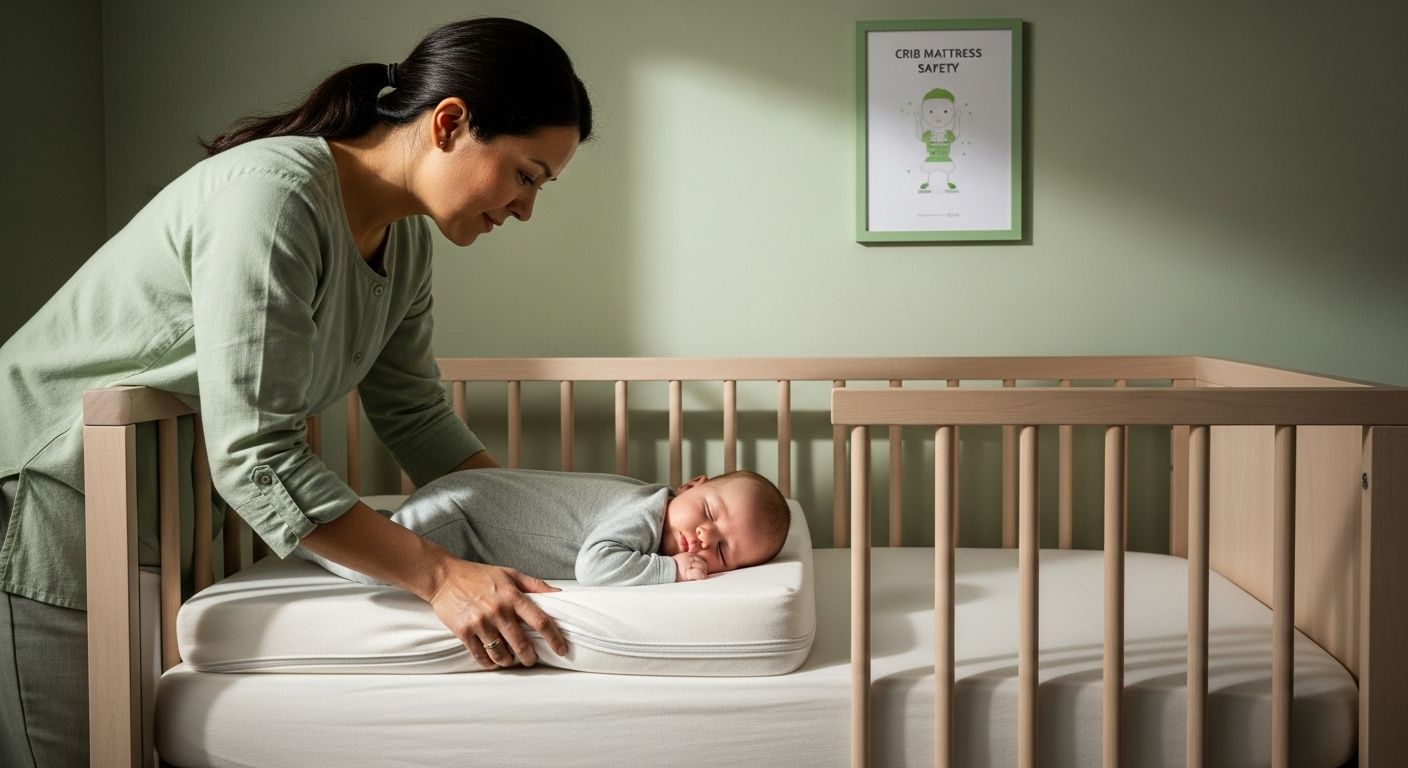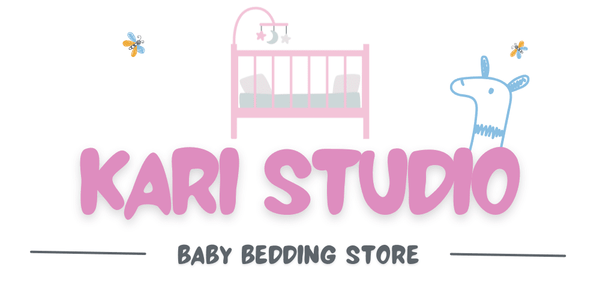Crib mattress safety often gets overlooked, yet it quietly shapes the foundation of every infant’s sleep.

Most people assume picking any soft mattress will keep a baby comfy, but research reveals a shocking reality. A mattress that’s too soft or doesn’t fit precisely increases the risk of suffocation and SIDS by up to 50 percent. That means the fluffier option could actually be the riskiest choice in the nursery.
Table of Contents
- What Is Crib Mattress Safety And Why Is It Important?
- Understanding The Materials And Construction Of Crib Mattresses
- Identifying Safe Sleep Practices For Infants
- Recognizing Hazards And How To Mitigate Risks
- Key Guidelines For Choosing The Right Crib Mattress
Quick Summary
| Takeaway | Explanation |
|---|---|
| Choose a firm, flat mattress | A firm mattress reduces suffocation risks and supports healthy spinal development in infants. |
| Ensure proper mattress fit | The mattress should fit snugly in the crib to prevent gaps that could cause entrapment. |
| Use non-toxic, breathable materials | Select mattresses made from safe materials to avoid harmful chemicals and ensure airflow. |
| Follow safe sleep practices | Always place infants on their back and keep their sleep area clear of soft objects. |
| Regularly inspect the mattress | Check for wear, damage, or chemical off-gassing to maintain a safe sleep environment. |
What is Crib Mattress Safety and Why Is It Important?
Crib mattress safety represents a critical aspect of infant care that directly impacts a baby’s sleep environment and overall well-being. Parents and caregivers must understand that a safe crib mattress is not just about comfort, but about preventing potential life-threatening risks during an infant’s most vulnerable sleeping stages.
Understanding the Fundamental Safety Requirements
A safe crib mattress must meet specific criteria that protect infants from accidental harm. According to the U.S. Consumer Product Safety Commission, these critical safety standards include:
- Mattress must be firm and flat to prevent suffocation risks
- No significant gaps between mattress and crib walls
- Proper size and dimension matching for the specific crib model
- Made from non-toxic, breathable materials
- Able to withstand consistent use without structural degradation
Potential Risks of Improper Mattress Selection
Choosing an inappropriate mattress can expose infants to serious health hazards. Soft or ill-fitting mattresses increase risks of sudden infant death syndrome (SIDS), suffocation, and potential physical entrapment. Babies cannot reposition themselves effectively, making a safe sleep surface absolutely critical.
Parents should prioritize mattress firmness and precise fit when selecting a sleeping surface for their infant. A proper crib mattress provides the necessary support for spinal development while creating a secure sleeping environment that minimizes potential dangers.
The investment in a high-quality, safety-compliant crib mattress is not just a purchase but a fundamental protective measure for an infant’s health and survival. Understanding and implementing these safety guidelines can significantly reduce sleep-related risks and provide peace of mind for caregivers.
Understanding the Materials and Construction of Crib Mattresses
Crib mattress construction involves complex design considerations that directly impact infant safety and comfort. Understanding the intricate materials and manufacturing processes helps parents make informed decisions about their baby’s sleep environment.
Core Construction Materials
Crib mattresses typically utilize two primary construction approaches: foam and innerspring. Foam mattresses are lightweight, often made from polyurethane or memory foam with varying density levels. Innerspring mattresses feature metal coils surrounded by padding layers, providing structured support.
Key material characteristics parents should evaluate include:
- Density and firmness of foam
- Coil gauge and quantity in innerspring models
- Quality of cushioning layers
- Breathability of surface materials
- Resistance to moisture and potential bacterial growth
Safety and Performance Considerations
According to the U.S. Consumer Product Safety Commission, mattress construction must meet rigorous safety standards. Manufacturers must ensure:
- No exposed coil springs or sharp edges
- Consistent mattress firmness across entire surface
- Non-toxic materials that do not off-gas harmful chemicals
- Ability to withstand repeated cleaning and sanitization
The ideal crib mattress balances structural integrity with infant comfort. While firmness prevents suffocation risks, subtle cushioning supports healthy spinal development. Parents should prioritize mattresses constructed with medical-grade, hypoallergenic materials that maintain shape and provide uniform support throughout repeated use.
Comprehensive research into mattress materials reveals that construction quality directly correlates with infant sleep safety. Investing in a well-constructed, professionally engineered crib mattress represents a critical step in creating a secure sleeping environment for newborns and infants.
Identifying Safe Sleep Practices for Infants
Safe infant sleep represents a critical area of pediatric health that requires consistent, evidence-based practices to minimize risks of sudden infant death syndrome (SIDS) and other sleep-related accidents. Parents and caregivers must understand comprehensive strategies that protect babies during their most vulnerable sleeping periods.
Fundamental Sleep Environment Guidelines
Creating a secure sleep environment involves more than selecting an appropriate mattress. Positioning and surrounding conditions play pivotal roles in infant safety. The American Academy of Pediatrics recommends several critical guidelines:
- Always place babies on their back when sleeping
- Use a firm, flat surface without additional bedding
- Maintain a consistent room temperature between 68-72 degrees Fahrenheit
- Keep the sleeping area free from soft objects, pillows, and loose blankets
- Ensure proper ventilation in the infant’s sleep space
Reducing Sleep-Related Risks
Infant sleep safety extends beyond physical positioning. Monitoring and proactive prevention are essential strategies for protecting vulnerable newborns. Key risk reduction techniques include:
- Using a dedicated crib or bassinet
- Avoiding co-sleeping or bed-sharing arrangements
- Maintaining a smoke-free environment
- Ensuring consistent adult supervision during infant sleep periods
- Using a fitted sheet specifically designed for infant mattresses
Parents should recognize that every sleep session represents an opportunity to implement safety protocols. Consistent application of recommended practices significantly reduces potential hazards. The sleeping environment should prioritize minimalism, focusing on essential safety elements rather than decorative or comfort-oriented additions.
Ultimately, understanding and implementing comprehensive safe sleep practices requires ongoing education and vigilance. By remaining informed about current pediatric recommendations and maintaining a disciplined approach to infant sleep environments, caregivers can substantially mitigate potential risks and create a secure foundation for healthy infant development.
Recognizing Hazards and How to Mitigate Risks
Crib mattress safety involves understanding and preemptively addressing potential risks that could compromise an infant’s sleeping environment. Comprehensive risk management requires parents and caregivers to be vigilant about potential hazards that might not be immediately apparent.
Common Mattress-Related Safety Hazards
Several critical risk factors can transform an otherwise safe sleeping surface into a potential danger zone. Structural integrity and material composition play crucial roles in determining overall mattress safety. Parents should be alert to potential hazards such as:
- Improper mattress sizing creating dangerous gaps
- Soft or overly plush mattress surfaces
- Deteriorating mattress materials
- Potential chemical off-gassing from low-quality materials
- Inadequate breathability leading to heat retention
Risk Mitigation Strategies
According to the U.S. Consumer Product Safety Commission, proactive risk management is essential in creating a safe infant sleeping environment. Effective mitigation strategies include:
- Regular mattress inspections for wear and damage
- Ensuring precise fit within the crib frame
- Selecting mattresses with certified safety standards
- Using only firm, flat mattress surfaces
- Avoiding secondary mattress modifications
Systematic evaluation of the sleep environment represents the most effective approach to infant safety. Parents must understand that risk mitigation is an ongoing process requiring consistent attention and periodic reassessment. Simple visual and tactile inspections can reveal potential issues before they become serious safety concerns.
Below is a table summarizing common mattress-related hazards and recommended risk mitigation strategies. This quick reference can help you identify issues and take steps to ensure your baby's sleeping environment remains safe.
| Hazard | Description | Mitigation Strategy |
|---|---|---|
| Improper Mattress Sizing | Gaps between mattress and crib walls | Ensure snug mattress fit with no significant gaps |
| Soft/Overly Plush Surface | Increases risk of suffocation | Choose a firm, flat mattress surface |
| Deteriorating Materials | Wear or breakdown exposes baby to risks | Inspect mattress regularly for signs of wear or damage |
| Chemical Off-gassing | Emission of harmful chemicals from low-quality materials | Select non-toxic, certified materials |
| Poor Breathability | Can cause heat retention or discomfort | Pick mattresses with breathable surface materials |
Use this table to quickly recognize hazards and keep your baby's crib mattress safe.
Beyond physical mattress characteristics, environmental factors also contribute to overall infant safety. Maintaining appropriate room temperature, ensuring proper ventilation, and eliminating potential suffocation hazards are equally important components of comprehensive risk management. The goal is not just to select a safe mattress, but to create an entire sleeping ecosystem that protects and supports infant health.
Key Guidelines for Choosing the Right Crib Mattress
Selecting an appropriate crib mattress requires careful consideration of multiple factors that directly impact infant safety and comfort. Parents must approach this decision with comprehensive understanding and strategic evaluation of multiple critical elements.
Essential Mattress Selection Criteria
Mattress firmness represents the most crucial factor in infant sleep safety. A properly constructed mattress supports healthy physical development while minimizing potential suffocation risks. Parents should prioritize evaluating the following core characteristics:
- Consistent firmness across entire surface
- Minimal surface depression when infant is placed
- Rapid restoration of original shape after pressure
- Constructed from breathable, non-toxic materials
- Meets current safety certification standards
Practical Evaluation Strategies
Beyond basic specifications, parents need practical methods for assessing mattress quality. The National Institutes of Health recommends comprehensive evaluation techniques that go beyond visual inspection:
- Press center and edges of mattress to test structural integrity
- Verify precise measurements matching specific crib dimensions
- Check for seamless, reinforced edges preventing potential entrapment
- Evaluate weight and density of mattress materials
- Confirm manufacturer’s safety certifications and testing protocols
Ultimately, informed selection involves understanding that a crib mattress is more than a simple sleeping surface. It represents a critical protective environment supporting an infant’s most vulnerable developmental stages. Parents should approach mattress selection as an investment in their child’s safety, prioritizing scientific design and rigorous safety standards over aesthetic considerations or cost-saving measures.

The right crib mattress transcends mere comfort, serving as a foundational element in creating a secure, supportive sleep environment that promotes healthy infant growth and development.

Give Your Baby the Safe Sleep Start They Deserve
You know how vital a safe crib mattress is for your baby’s well-being. After reading about the risks of gaps, chemical exposure, and improper fit, it is clear that every detail in your baby’s sleep environment matters. If you worry about providing a firm, hazard-free space for your child, you are not alone. Many parents, just like you, face the challenge of turning safety guidelines into everyday peace of mind.

Make your nursery safer right now. Explore Kari Studio’s curated collection of nursery essentials and accessories designed with safety and comfort at the core. See how our products help you meet the very best standards for your baby’s crib, mattress, and room design. Visit Kari Studio today to find the trusted solutions other careful parents rely on. Your baby’s future begins with safe sleep—shop now to ensure every night is worry-free.
Frequently Asked Questions
What factors should I consider when selecting a crib mattress for my baby?
When choosing a crib mattress, prioritize firmness, ensuring it’s flat and provides adequate support, as well as fit, ensuring there are no gaps between the mattress and crib walls. Look for non-toxic, breathable materials that meet safety standards.
How can I ensure the crib mattress is safe for my baby?
Inspect the mattress for any sharp edges or exposed coils, and verify that it maintains consistent firmness. The mattress should also be constructed from non-toxic materials that do not off-gas harmful chemicals and fit securely within the crib frame.
What are the risks associated with using a soft mattress for infants?
Soft or overly plush mattresses can increase the risk of suffocation and SIDS (sudden infant death syndrome) because babies cannot reposition themselves effectively. To minimize these risks, opt for a firm mattress that provides adequate support.
How often should I inspect my baby’s crib mattress for safety?
Regular inspections of the mattress are recommended to check for wear, damage, or deterioration. Ensuring the mattress maintains its safety features is critical throughout its use, and you should look for any signs of structural integrity issues or material degradation.

